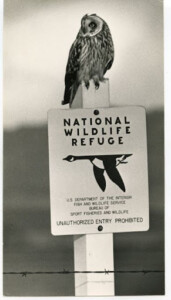Willamette Valley National Wildlife Refuges

Gerry Lewin, Animals: Owl perched on the top of a post with sign “National Wildlife Refuge”, WHC Collections 2016.023.0098.037
The three Western Oregon refuges in the Willamette Valley are part of more than 500 refuges in the National Wildlife Refuge System administered by the U.S. Fish and Wildlife Service. The Service also manages national fish hatcheries and provides Federal leadership in habitat protection, fish and wildlife research, technical assistance, conservation and protection of migratory birds, certain marine mammals and threatened and endangered species.
The original Willamette Valley was a rich mix of wildlife habitats. Valley wetlands were once extensive with meandering stream channels and vast seasonal marshes. As people have altered the natural landscape to meet their own needs, wildlife have not always benefited.
Today, the Willamette Valley is a pleasant mix of farmland and growing cities with fewer areas remaining for wildlife. Three National Wildlife Refuges (NWR) were created in the 1960s – William L. Finley, Ankeny, and Baskett Slough NWR – to preserve and restore some of the vanishing native habitats for wildlife. They are intensively managed to meet the needs of many species, especially those confined to small or limited ranges.
The primary management goal on the Willamette Valley refuges is to provide wintering habitat for dusky Canada geese. Unlike other Canada geese, duskies have limited summer and winter ranges. They nest on Alaska’s Copper River Delta and winter almost exclusively in the Willamette Valley. Habitat loss, predation and hunting have caused a decrease in population.
Wildlife Throughout the Year
Spring: Pacific tree frogs start shrilling with the first February thaw and rough-skinned newts begin the overland trek to spawn in open water. Wintering waterfowl flocks start migrating north in March, shorebirds migrate through in April. Song bird migration peaks in early May coinciding with the height of spring wildflowers.
Summer: Broods of mallards, hooded mergansers and wood ducks appear in June, and turtles can be seen basking on logs. Ox-eye daisies, lupines, wild hollyhocks and delphiniums cover refuge fields and roadsides. Black-tailed deer appear with fawns in tow; squirrels, birds, and the occasional black bear gorge on July blackberry crop.
Fall: Song birds start to migrate south in August and flocks of geese begin to fill the skies in late September. Roosevelt elk go into rut and can be heard bugling at Finley NWR at dusk. Sightings of migrating raptors increase in September. Rough-legged hawks arrive in October as turkey vultures depart.
Winter: Thousands of geese, ducks and swans can be seen grazing on refuge fields through the winter. Small numbers of bald eagles and the occasional peregrine falcon can be seen hunting the wintering flocks. Raptor sightings are common as resident birds are joined by migrants from further north.
For more information, contact:
Refuge Manager
Western Oregon NWRs Complex
26208 Finley Refuge Road
Corvallis, Oregon, 97333 (541) 757-7236 Fax (541) 757-4450
Bibliography:
“Willamette Valley National Wildlife Refuges”,U.S. Department of Interior,Fish and Wildlife Service, publication RF13590, August, 1994
Photo by David Goodson
This article originally appeared on the original Salem Online History site and has not been updated since 2006.







Leave A Comment